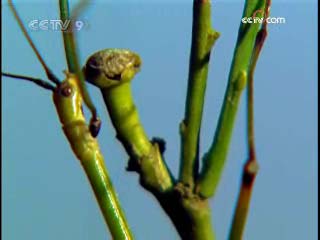------Program code: NS-080901-01643 (what's this?)
Source: CCTV.com
09-01-2008 10:10
At nightfall, a stick insect slowly crawls up a branch. It’s looking for food. This master of disguise looks like a stick. Even so, it’s discovered by a red tree ant.
 |
The ant sprays a toxin in the air. It’s a signal calling the other ants. The plan is to prey on the stick insect, the longest insect in the world. The sickle-like mandibula on their heads grip the stick insect tightly. At the same time, their tails start to release formic acid, a toxin that can paralyze their prey.
 |
More and more red tree ants come and join the team.
Finally the giant insect dies under the continuous waves of attack. In this seemingly tranquil forest, such deadly scenes are played out every day.
Before dawn, the silent forest is enveloped in a mist.
The clouds drift across the southern sky above Hainan Island. They arrive over the largest primeval tropical rainforest in China.
Jianfengling, at 1,412 metres, is the highest point in the rainforest.
The rainforest surrounding Jianfengling contains 15% of all the plant species found in China. It is also home to 104 reptiles and 76 animal species. Biologists call it a gene bank of northern tropical flora and fauna.
Globally, the tropical rainforest is formed into belts, centered on the Equator and radiating outwards to the Tropics of Capricorn and Cancer. In China, the places that fall within this area include Hainan Island, Xishuangbanna in Yunnan, southeastern Tibet and areas of Guangdong, Guangxi, and Taiwan.
After the mist has gone, a red tree ant leaves home. He is searching for more food.
A 20-metre high Hainan madhuca tree stands by the stream. At its top is a nest wrapped in leaves. This is the home of the red tree ants.
The branches and leaves in the rain forest are food for the insects. Red tree ants are essentially meat eaters. They prey principally on stink bugs, jewel beetles, longhorn beetles and other insects living on the tree leaves. The Hainan madhuca trees offer a shelter for the red tree ants and, in return, they protect the trees from leaf-eating insects.
On another tree, the red tree ants are building a new nest. There are tens of thousands of ants in this colony, which makes a new nest essential. Some of the ants lie across two leaves and draw them close to each other, while others hold mature larvae in their mouths and force them to spit silk between the leaves to glue them together.
During the nest-building process different types of ants have distinct work assignments. The level of cooperation is remarkable. A nest is wrapped in layers from the inside, outwards. It takes one or two days to finish. The process is the source of the red tree ant’s alternative name – the weaver ant.
At the entrance to the nest, soldier ants are on patrol. Every ant returning home will be carefully inspected by the guards. They are allowed to pass only after their identity is confirmed.
Some worker ants are weaving, while others are herding. Their rangeland extends to another small tree not far from their home. The aphid has a needle mouth, which can penetrate the surface of plants and suck out the nutrients.
Every minute or two, the aphids will raise their bellies and excrete honeydew containing sugar. A worker ant comes and scrapes the honeydew away with its mandibula and swallows it. One worker ant can herd several aphids at a time. It will move backwards and forwards among the aphids, licking up the honeydew. In this win-win situation, the ants protect the aphids against their natural enemies, while the aphids offer their protectors honeydew.
An ant will keep only 20% of the honeydew it collects. It will share the remaining 80% with its family.
Ants live in a highly organized society. All the worker ants in the colony are infertile females. Their responsibilities include hunting for food, fighting, protecting the home and caring for the new members produced by the queen ant.
Most of the greenery on Jianfengling is evergreen broadleaf trees. But here, more than a hundred tree species grow in a single hectare, with the result that no specific species has any advantage over the others. Several hundred meters away from the Hainan madhuca tree, a red tree ant and a few companions are looking for food on a green plum tree.
In this forest, the green plum and hopea lplagata are the only two dipterocarpaceae trees. In the tropical rain forests of Asia, dipterocarpaceae are the main tall trees. As such, their presence identifies an Asian tropical rainforest.
Editor:Yang
